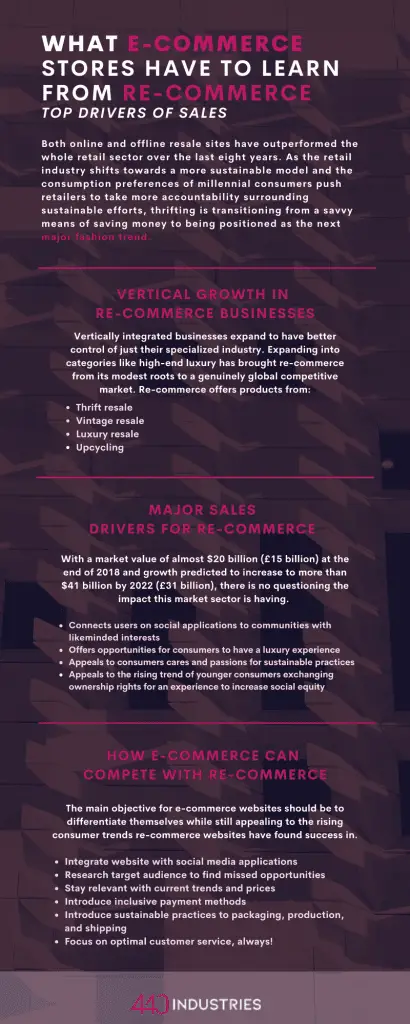Introduction
Both online and offline resale sites have outperformed the whole retail sector over the last eight years. As the retail industry shifts towards a more sustainable model and the consumption preferences of millennial consumers push retailers to take more accountability surrounding sustainable efforts, thrifting is transitioning from a savvy means of saving money to being positioned as the next major fashion trend.
The question is, will traditional e-commerce platforms be able to keep up? In the post, we’re going to cover why resale commerce platforms have found major success and what exactly regular e-commerce platforms can learn to stay competitive. Let’s get started!
- E-Commerce & Re-Commerce Platforms: What is the Difference?
- Vertical Growth Expansion in Re-commerce Businesses
- Major Drivers of Sales for Re-Commerce Platforms
- How Can a Regular Online E-Commerce Store Get Compete with a Re-Commerce store?
- Conclusions
1. E-Commerce & Re-Commerce Platforms: What is the Difference?
E-Commerce
Ecommerce or electronic commerce is a business model that is comprised of sales management software transactions for apparel, shoes, home goods, or really anything that is hosted on the web. They are websites where customers can purchase items that are only for sale on the internet but the business functions pretty much like how any physical retailer would. Users can buy goods and schedule shipping and payments on the same platform, without the need to contact a human to assist them with their purchase. Nearly every online shopping website, small or large, follows this structure.
Describing e-commerce as simply an “online business” is rather generic. There appear to be countless possibilities for e-commerce, with new types of platforms coming up all the time.
All e-commerce retailers getting started, begin by either joining a marketplace or by constructing their own.
- Marketplace: a third-party platform that provides product listings from several retailers across product categories. Examples include Amazon or Alibaba.
- Personal e-commerce website: an individual e-commerce website managed by the retailer, where the customer orders products directly from the website belonging to the brand. Many are developed using e-commerce platforms such as Shopify or Magento.
The main differences between marketplaces and eCommerce sites are simple, but really depend on who are and what the e-commerce business is selling. Marketplaces will connect the retailer to make millions of visitors, but they’ll also be competing for exposure against many sellers.
Re-commerce
At its core, re-commerce is a business model that falls under the e-commerce umbrella and is built around the idea of product reuse. Re-commerce, also known as reverse commerce, it a highly accessible model of purchasing and selling previously owned goods through an app or website. These types of platforms make it easier for consumers to browse for products at a lesser price.
Many firms involved in re-commerce are invested in products that are no longer readily accessible from the retailer. Perhaps the products have been phased out or failed to sell due to a lack of demand on since the initial launch began. These retailers then refurbish those items—or release never before used products—and reintroduce them to a new consumer that skipped the original product launch.
eBay pioneered the first re-commerce market by offering gently used, quality clothing for nearly a quarter of a century with the auction and direct sales. Although peer-to-peer transactions and selling has been popular on re-commerce platforms like Poshmark and Mercari, re-commerce is now becoming a huge part of the e-commerce and omnichannel retail boom.
Just about everybody has something of worth that they can resell, which is why resale has gained traction. Online marketplaces and re-commerce brands allow consumers to mail these products to them for payment or enable them to list products on their reselling pages or mobile apps. They can then receive a commission (a percentage of the selling value) on each item sold.
In the next sections, we’re going to focus on major sales drivers for popular re-commerce businesses, starting with sustainability in the fashion industry!
2. Vertical Growth Expansion in Re-commerce Businesses
Re-commerce has expanded a lot due to the growth of a few main verticals. Expanding into categories like high-end luxury has brought re-commerce from its modest roots to a genuinely global competitive market. All the way from thrift stores to the most luxurious boutiques and top designers, there’s an entire spectrum of businesses that follow this interesting re-commerce model.
Re-commerce platforms happen to be secondhand apparel dominated and usually offer one or more of the following types of resales:
- Thrift resale: Offers a broad range of products from low end to high end. Typically gently used clothing items sold at a discounted price.
- Vintage resale: Sells older, valuable products from high quality distinguished brands like Levi or Woolrich.
- Luxury resale: Sells goods and collectables from top designer fashion houses like Chanel and Versace
- Upcycling: Sells thrift, vintage, or luxury products that have been refurbished, repaired, or entirely converted into a new type of product.
As we can see here, sustainability is a major sales driver for re-commerce platforms.
The tides are turning and sustainability is becoming a greater initiative for many online businesses. Reselling provides an element of preservation, since these items are being reused and not merely discarded into trash repositories.
Though some shops are bringing in millions from this business model, the value of re-commerce goes beyond financial resources. It is about repurposing culture, while also fostering competitive sustainable practices of the industry.
Here are some more reasons why appealing to sustainable trends is becoming popular among online businesses:
- Encourages recycling: Consumers are encouraged to recycle and reuse garments that are in good condition, but that maybe they are not interested in using anymore.
- Saves space: People can keep a tidy closet by selling clothes that no longer fit or they no longer want.
- Saves money: second-hand products come at a discount price that lets buyers save money on things that would have been too costly to purchase at retail prices.
- Encourages conscious consumption: consumers are attracted to buying products that have good resale value.
3. Major Drivers of Sales for Re-Commerce Platforms
In line with the simultaneous growth of conscientious buyers, the resell industry has flourished. With a market value of almost $20 billion (£15 billion) at the end of 2018 and growth predicted to increase to more than $41 billion by 2022 (£31 billion), there is no questioning the impact this market sector is having. Second-hand, pre-owned luxury, antique – no matter how you spin it, reselling has become a massive business.
Let’s take a look at some of the other top sell drivers for re-commerce platforms:
- A social connection app all-in-one: Many re-commerce websites allow users to engage with each other in a powerful way. Community driven platforms personalize the consumer experience and increase discoverability of products they weren’t exposed to before. No longer does it feel like visiting shopping apps is just a process of spending money. It’s also an opportunity to engage with peers while expressing creativity.
- Re-commerce offers accessible luxury: Another trend that has fueled the resale market is the need to be continually seen in new clothes; amplified by social media sites like Instagram, and the stress to imitate fashion influencers. Intriguingly, this has often generated what is described as the ‘Serial Returner,’ or customers who regularly return products after they have been worn once or twice and shown on social media. However, with stores now placing restrictions on this kind of practice, customers are searching for opportunities to resell. In any case, a major draw for customers is that can now afford higher-end or luxury items that have been marked down in price.
- Re-commerce offers items for rent: Re-commerce brands are now positioning themselves in the rental market. Their selection for reusable items, such as clothes, shoes and furniture, reflects the convenience of subscription to the rental service: a guarantee of the lifestyle customers desire, without any upfront costs. This service addresses another consumer trend, which is the declining preference of ownership for millennial shoppers. More and more shoppers are focusing on experiences clothing can bring, whie becoming less interested in completely owning items.

4. How Can a Regular Online E-Commerce Store Get Compete with a Re-Commerce store?
Now that we have unpacked some of the reasons behind re-commerce’s immense success over the past few years, let’s discuss some strategies an e-commerce platform can implement to gain a competitive advantage.
- Optimize waste management and be transparent: Using sustainable and recyclable materials for packaging and choosing climate neutral shipping options is a great way to attract the profitable sustainable consumer segment. Also, being honest and transparent about the source of product materials/methods of production builds consumer trust and can potentially appeal to their interest in sustainability, depending the business practices. Are you interested in how businesses provide transparency to their customers? Read this post to learn more.
- Provide excellent customer service: Caring for customers is everything in an online business. There are many buyer and seller obligational relationships on re-commerce platforms that help limit liability for the re-commerce platform itself. For e-commerce businesses ran by one, or a few people, providing good customer service is a bit more challenging, but will pay off in the end with increased brand loyalty. This strategy should not be underestimated in the online business world.
- Integrate site with all forms of social media to stay relevant: A huge attraction to re-commerce platforms is the social interaction. There is a new era of second-hand fashion experts who are leveraging a blend of cultural nostalgia and social media savvy to drive commerce sales. Users can follow each other or curators they are interested in to receive notifications about new items in the shop. E-commerce owners should integrate their store with social media platforms like Instagram, Pinterest, and Facebook to build relationships with customers and introduce pop-cultural elements into their marketing.
- Know their audience so they can market to the right customers: Re-commerce platforms appeal to socially conscious consumers, frugal spenders, savvy reselling entrepreneurs, and fashion gurus looking for accessible luxury items. They market these selling points very well. E-commerce stores need to be able to specifically convey the value they bring to their target customers, otherwise, expensive marketing efforts could be a shot in the dark. For higher-priced items, consider offering discounts for products that consumers on the fence would be willing to purchase.
- Stay relevant and knowledgeable on the current trends and prices: Successful re-commerce stores have mastered the art of supply chain management and are always one step ahead when it comes to restocking inventory. Because the average inventory set is drained after roughly 2 weeks, re-commerce is prone to experiencing shortages. While other types of online retailers may not churn out inventory as quickly, closely following projected trends can help mitigate this risk just to be on the safe side. It will also help e-commerce businesses know which products to push for the season.
- Offer opportunities for customers to have a “luxury” experience: The inclusive nature of re-commerce websites combined with the popular trend of social media fashion influencing, makes for a highly profitable relationship. Even if an e-commerce website does not sell luxurious items, chances are there are products that their visiting users are interested in but perhaps do not have enough money at the time to purchase. By implementing more inclusive options to obtain these products, the consumers will be more likely to purchase and come back for more, even if it is not priced at the same rate. Some platforms offer payment plans or major sales events to do this.
5. Conclusions
We hope you enjoyed reading our What E-Commerce Stores Have to Learn from Re-Commerce Websites: Top Drivers of Sales! Let’s recap all that we have covered:
The main objective for e-commerce websites should be to differentiate themselves while still appealing to the rising consumer trends re-commerce websites have found success in. It may take serious work and effort to ramp up sales, but in the end, will all be worth it.
Looking at the major sales drives of re-commerce businesses is a good place to start thinking of inspiration for how to differentiate:
- Connects users on social applications to communities with like-minded interests.
- Offers opportunities for consumers to have a luxury experience.
- Appeals to consumers’ cares and passions for sustainable practices.
- Appeals to the rising trend of younger consumers exchanging ownership rights for an experience to increase social equity.
Considering these drivers, e-commerce businesses should:
- Integrate their website with social media applications.
- Research their target audience to find missed opportunities.
- Stay relevant on current trends and prices.
- Introduce inclusive payment methods to give more consumers the chance to experience the products.
- Introduce sustainable practices to the workflow, whether that be in production or packaging waste management.
- Focus on optimal customer service, always!








